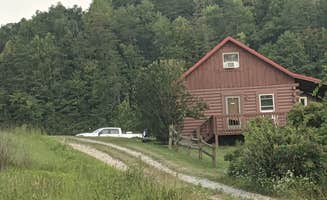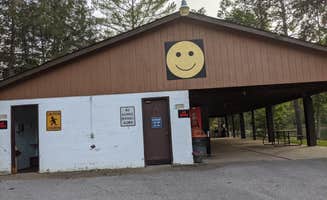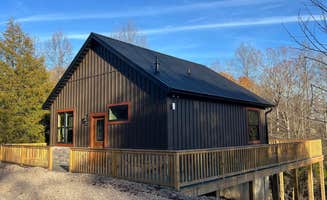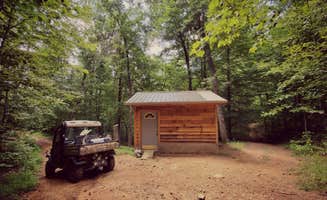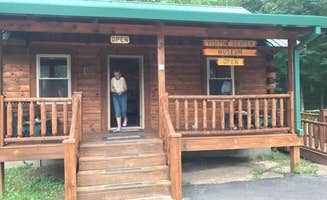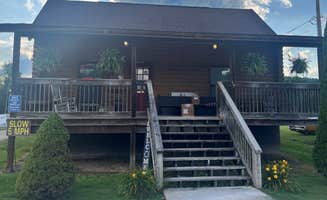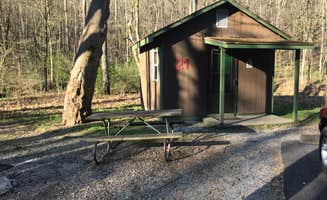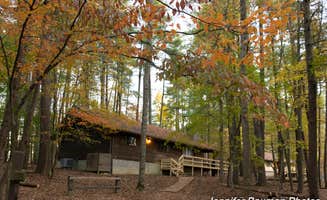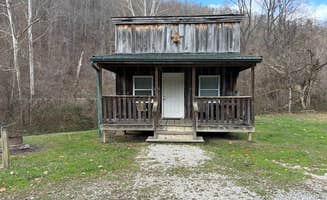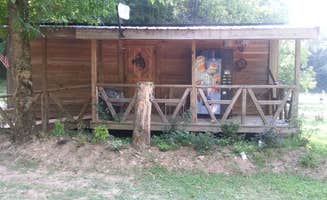Cabin camping near Ripley, West Virginia offers access to several waterways including the Ohio River, North Fork Hughes River, and Middle Fork Creek. The region sits within the Appalachian Plateau with elevations ranging from 600-1,200 feet and receives approximately 44 inches of rainfall annually. Most cabin sites remain open April through October, though some provide year-round accommodations with heating systems for winter visitors.
What to do
Fishing opportunities: North Bend State Park sits at the halfway point of the 72-mile North Bend Rail Trail, offering excellent fishing access. "I paddled on the North Bend Lake which was extremely peaceful and beautiful, with the colors of fall surrounding me on all sides... fishermen told me they catch bass and catfish at this 300-acre lake," notes a visitor to River Run Campground.
Water activities: Cabins near several lakes provide swimming and boating options during summer months. At Forked Run State Park Campground, visitors enjoy "the man made sandy beach on the lake" and unique wildlife. "What makes the lake unique at Forked Run is that it contains dime sized fresh water jelly fish. These type aren't able to sting you," explains one camper.
Historical exploration: The region features industrial heritage sites within short driving distance from cabin locations. "Hope furnace is just outside the campground and next to the first 'put-in' for the lake. As history buffs will know that Ohio was one of the nation's leading iron producers back in the day," writes a visitor to Lake Hope State Park.
What campers like
Waterfront locations: Many cabins offer water views or direct access to lakes and ponds. At Rippling Waters Church of God Campgrounds, a guest describes their experience: "We were placed in a pull thru on the lake. What a spot!! We watched the resident swan swim around the fountain and I got to play with my camera perfecting my skills with day and night shots of the Chapel."
Privacy options: Some cabin locations provide more secluded settings away from main camping areas. A visitor to Farver Acres explains: "Our stay at this incredible campground was nothing short of magical. With three spacious gravel sites nestled in a quiet, serene setting, it truly felt like our own private escape from the world. We didn't see another person for four full days."
Hiking access: Multiple trail systems connect directly to cabin areas for convenient outdoor recreation. "North Bend State Park is located at the halfway point of the 72-mile North Bend Rail Trail, so it's a great camping spot for hikers, bikers and horseback riders who want to explore this scenic trail which crosses 35-bridges and cuts through 11-tunnels where the B&O Railroad used to travel," reports a camper.
What you should know
Bathroom facilities vary: Cabin locations offer significantly different restroom options depending on price point and location. At Forked Run, a guest observed: "The pit toilets were filthy- covered in flies, spiderwebs and dirt. They look like they have not been hosed out since the 70's. The showers and sinks are in an old, old building."
Site leveling challenges: Many cabin and RV areas in this region feature uneven terrain requiring preparation. "Sites are very bad for tent camping and not the best for RV's. Back ins are short and most sites have no level ground even for the picnic table or fire ring," notes a reviewer at Forked Run State Park.
Water quality concerns: Some locations may have water treatment issues affecting shower comfort. "Water also had a strong odor of chlorine. After showers I felt like I was just getting out of a pool," explains a visitor to Huntington / Fox Fire KOA.
Tips for camping with families
Swimming options: Several cabin locations feature swimming areas designed specifically for children. At Lake Hope, a visitor mentioned: "We also did some kayaking as well as driving to different hiking paths around the area... my family and I even spent some time at the lake and rented a paddle board and a water bike which was so much fun!"
Consider seasonal timing: Many family-friendly amenities operate on limited schedules. "Camp store wasn't open yet for the season no other staff was seen except one guy cleaning on loop A," reports a camper at Forked Run in May, suggesting early season visitors should bring all supplies.
Playground access: Recreation areas for children vary significantly between cabin locations. At Statts Mills Campground, a visitor cautions: "The swings were all broken and on the ground in the playground, the picnic tables were broken and falling apart, the grass had not been cut," indicating the need to research current facilities before booking.
Tips from RVers
Electric reliability: Power supply varies between cabin and RV sites in the region. "The electricity did not work in all of the sites," notes a visitor to Statts Mills Campground, suggesting checking hookups immediately upon arrival.
Site size limitations: Many locations have restricted space for larger vehicles despite advertising RV compatibility. "The entrance does not accommodate an RV or a large camper even though the owner said it did," warns a Statts Mills visitor, highlighting the importance of calling ahead to confirm access.
Water pressure management: Some locations deliver very strong water pressure requiring regulation equipment. At Farver Acres, a camper advises: "The water pressure at the site was excellent — just be sure to bring a water pressure regulator to ensure a comfortable experience."


